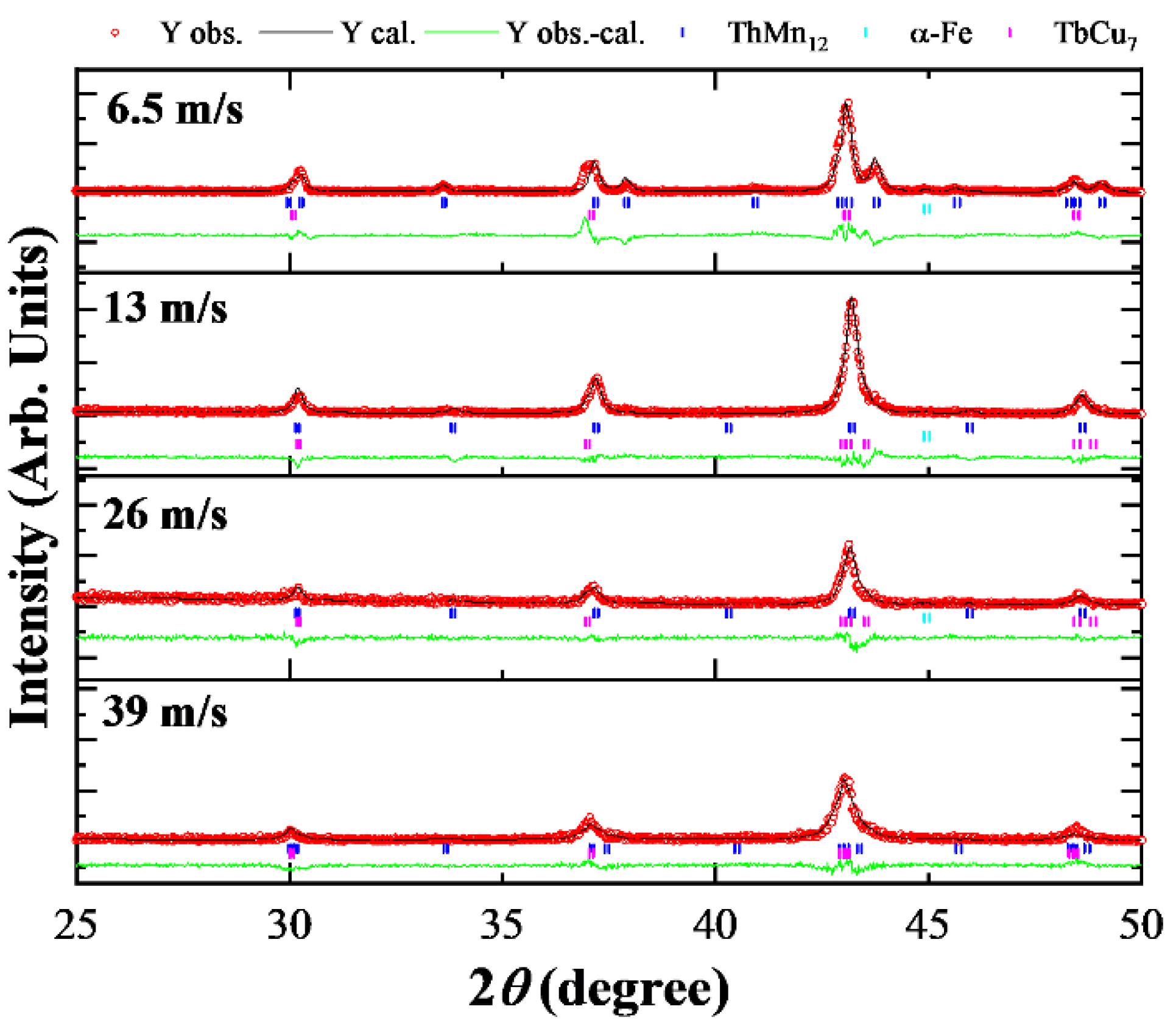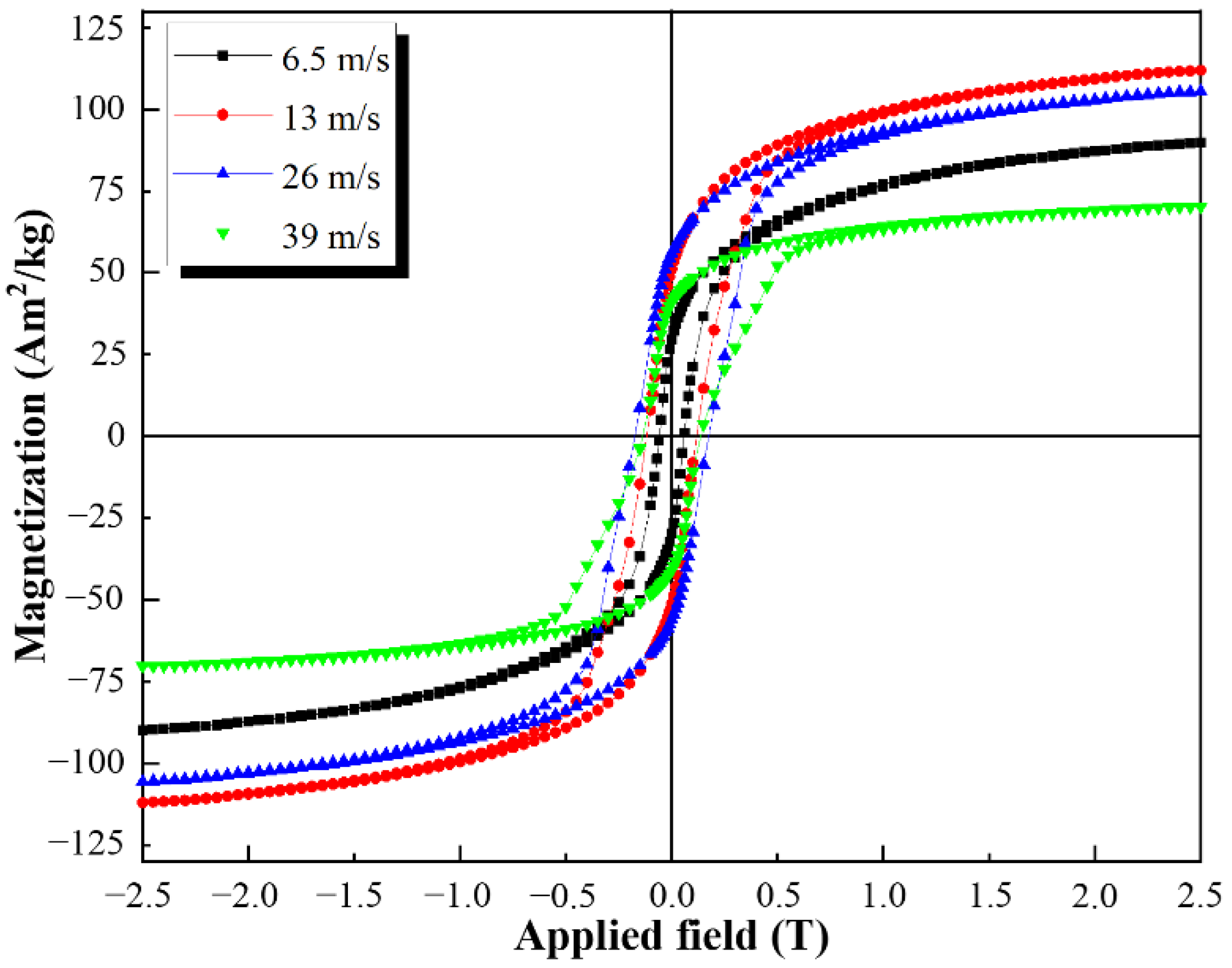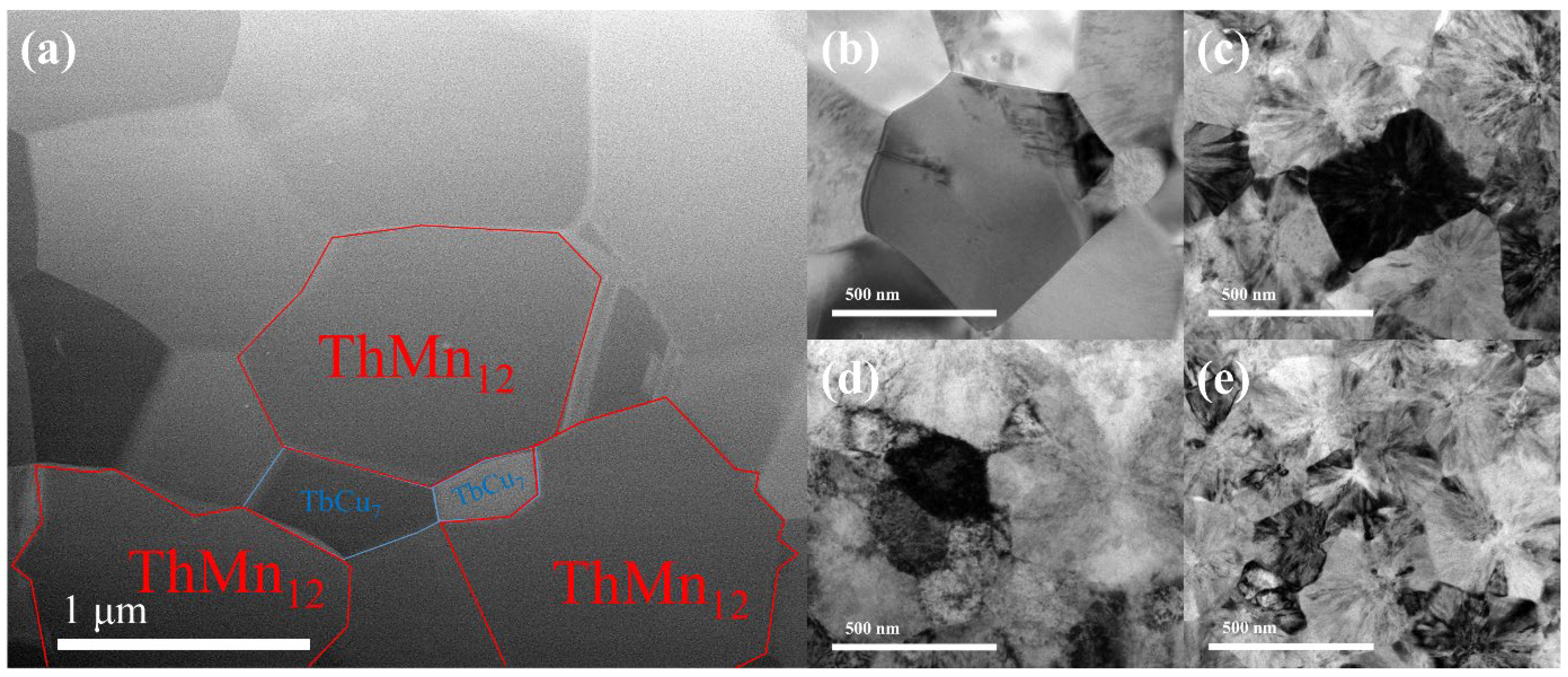Physical and Magnetic Properties of ThMn12-Type Sm(Fe0.8Co0.2)10Si2 Melt-Spun Ribbons
Abstract
:1. Introduction
2. Experiment
3. Results and Discussion
4. Conclusions
Author Contributions
Funding
Conflicts of Interest
References
- Hadjipanayis, G.C.; Gabay, A.M.; Schönhöbel, A.M.; Martín-Cid, A.; Barandiaran, J.M.; Niarchos, D. ThMn12-type alloys for permanent magnets. Engineering 2020, 6, 141–147. [Google Scholar] [CrossRef]
- Gabay, A.M.; Hadjippanayis, G.C. ThMn12-type structure and uniaxial magnetic anisotropy in ZrFe10Si2 and Zr1−xCexFe10Si2 alloys. J. Alloys Compd. 2016, 657, 133–137. [Google Scholar] [CrossRef] [Green Version]
- Hirayama, Y.; Takahashi, Y.K.; Hirosawa, S.; Hono, K. Intrinsic hard magnetic properties of Sm(Fe1−xCox)12 compound with the ThMn12 structure. Scr. Mater. 2017, 138, 62–65. [Google Scholar] [CrossRef]
- Takahashi, Y.K.; Sepehri-Amin, H.; Ohkubo, T. Recent advances in SmFe12-based permanent magnets. Sci. Technol. Adv. Mater. 2021, 22, 449–460. [Google Scholar] [CrossRef]
- Ogawa, D.; Xu, X.D.; Takahashi, Y.K.; Ohkubo, T.; Hirosawa, S.; Hono, K. Emergence of coercivity in Sm(Fe0.8Co0.2)12 thin films via eutectic alloy grain boundary infiltration. Scr. Mater. 2019, 164, 140–144. [Google Scholar] [CrossRef]
- Fuji, H.; Sun, H. Interstitially modified intermetallics of rare earth and 3D elements. In Handbook of Magnetic Materials; Springer Science+Business Media: New York, NY, USA, 1995; Volume 9, pp. 303–404. [Google Scholar] [CrossRef]
- Tozman, P.; Sepehri-Amin, H.; Takahashi, Y.K.; Hirosawa, S.; Hono, K. Intrinsic magnetic properties of Sm(Fe1−xCox)11Ti and Zr-substituted Sm1−yZr(Fe0.8Co0.2)11.5Ti0.5 compounds with ThMn12 structure toward the development of permanent magnets. Acta Mater. 2018, 153, 354–363. [Google Scholar] [CrossRef]
- Tozman, P.; Sepehri-Amin, H.; Zhang, L.T.; Wang, J.; Xu, X.D.; Hono, K. An alternative approach to the measurement of anisotropy field—Single grain extraction. J. Magn. Magn. Mater. 2020, 494, 165747. [Google Scholar] [CrossRef]
- Kuno, T.; Suzuki, S.; Urushibata, K.; Kobayashi, K.; Sakuma, N.; Yano, M.; Kato, A.; Manabe, A. (Sm,Zr)(Fe,Co)11.0-11.5Ti1.0-0.5 compounds as new permanent magnet materials. AIP Adv. 2016, 6, 025221. [Google Scholar] [CrossRef] [Green Version]
- Coehoorn, R. Electronic structure and magnetism of transition-metal-stabilized YFe12−xMx intermetallic compounds. Phys. Rev. B. 1990, 41, 11790. [Google Scholar] [CrossRef]
- Li, H.S.; Coey, J.M.D. Magnetic properties of ternary rare-earth transition-metal compounds handbook of magnetic materials. In Handbook of Magnetic Materials; Springer Science+Business Media: New York, NY, USA, 1991; Volume 6, pp. 1–83. [Google Scholar] [CrossRef]
- Fukazawa, T.; Akai, H.; Hirayama, Y.; Miyake, T. First-principles study of intersite magnetic couplings and curie temperature in RFe12−xCrx (R=Y. Nd, Sm). J. Phys. Soc. Jpn. 2018, 87, 044706. [Google Scholar] [CrossRef] [Green Version]
- Chen, N.X.; Hao, S.Q.; Wu, Y.; Shen, J. Phase stability and a site preference of Sm(Fe, T)12. J. Magn. Magn. Mater. 2001, 233, 169–180. [Google Scholar] [CrossRef]
- Buschow, K.H.J. Permanent magnet materials based on tetragonal rare earth compounds of the type RFe12−xMx. J. Magn. Magn. Mater. 1991, 100, 79–89. [Google Scholar] [CrossRef]
- Bacmann, M.; Baudelet, C.; Fruchart, D.; Gignoux, D.; Hlil, E.K.; Krill, G. Exchange interactions and magneto-crystalline anisotropy in RFe12-xMx and parent interstitial compounds. J. Alloys Compd. 2004, 383, 166–172. [Google Scholar] [CrossRef]
- Gabay, A.M.; Schegoleva, N.N.; Belozerov, E.V. The structure and hard magnetic properties of rapid quenched (Sm,Zr)1(Fe,Si)12 alloys. Phys. Met. Metallogr. 2002, 94, 252–257. [Google Scholar]
- Ding, J.; Rosenberg, M. Magnetic properties of melt spun and crystallized SmFe10M2. J. Magn. Magn. Mater. 1990, 83, 257–258. [Google Scholar] [CrossRef]
- Gabay, A.M.; Hadjippanayis, G.C. Mechanochemical synthesis of magnetically hard anisotropic RFe10Si2 powders with R representing combinations of Sm, Ce, and Zr. J. Magn. Magn. Mater. 2017, 422, 43–48. [Google Scholar] [CrossRef] [Green Version]
- Qian, H.D.; Lim, J.T.; Kim, J.W.; Yang, Y.; Zhou, T.H.; An, S.Y.; Jeon, H.K.; Cho, K.M.; Park, J.H.; Choi, C.J. Crystallization and magnetic properties of ThMn12-type Sm-Fe-Co-Ti-Si based magnetic materials. J. Mater. Res. Technol. 2022, 16, 1458–1465. [Google Scholar] [CrossRef]
- Qian, H.D.; Lim, J.T.; Kim, J.W.; Yang, Y.; Cho, K.M.; Park, J.H.; Choi, C.J. Phase transformation and magnetic properties of fully dense Sm(Fe0.8Co0.2)11Ti bulk magnets. Scr. Mater. 2021, 193, 17–21. [Google Scholar] [CrossRef]
- Kuno, T.; Yamamoto, T.; Urushibata, K.; Kobayashi, K.; Sugimoto, S. Preparation of High-Coercivity Magnetic Powder via Heat Treatment of a Rapidly Quenched Amorphous Starting Compound with a ThMn12 Structure. Mater. Trans. 2020, 61, 657–662. [Google Scholar] [CrossRef]
- Saito, T.; Miyoshi, H.; Nishio-Hamane, D. Magnetic properties of Sm–Fe–Ti nanocomposite magnets with a ThMn12 structure. J. Alloys Compd. 2012, 519, 144–148. [Google Scholar] [CrossRef]
- Grössinger, R.; Krewenka, R.; Sun, X.K.; Eibler, R.; Kirchmayr, H.R.; Buschow, K.H.J. Magnetic phase transitions and magnetic anisotropy in Nd2Fe14−xCoxB compounds. J. Less Comm. Met. 1986, 124, 165–172. [Google Scholar] [CrossRef]
- Hirosawa, S.; Matsuura, Y.; Yamamoto, H.; Fujiura, S.; Sagawa, M.; Yamauchi, H. Magnetization and magnetic anisotropy of R2Fe14B measured on single crystals. J. Appl. Phys. 1986, 59, 873. [Google Scholar] [CrossRef]





| Wheel Speed (m/s) | ThMn12 | TbCu7 | ThMn12 (wt. %) | TbCu7 (wt. %) | α-Fe (wt. %) | ||||||
|---|---|---|---|---|---|---|---|---|---|---|---|
| a (Å) | c (Å) | c/a | V(Å3) | a (Å) | c (Å) | c/a | V(Å3) | ||||
| 6.5 | 8.432 | 4.748 | 0.5631 | 12.98 | 4.854 | 4.183 | 0.8618 | 36.54 | 94.5 | 4.7 | 0.8 |
| 13 | 8.378 | 4.820 | 0.5753 | 13.01 | 4.847 | 4.148 | 0.8558 | 36.62 | 84.5 | 14.7 | 0.8 |
| 26 | 8.384 | 4.838 | 0.5771 | 13.08 | 4.863 | 4.156 | 0.8546 | 36.81 | 70.2 | 29.8 | 0 |
| 39 | 8.424 | 4.804 | 0.5703 | 13.11 | 4.850 | 4.212 | 0.8685 | 36.90 | 57.1 | 42.9 | 0 |
| Wheel Speed (m/s) | M2.5T (Am2/kg) | Mr (Am2/kg) | Hc (T) | Tc1 (K) | Tc2 (K) |
|---|---|---|---|---|---|
| 6.5 | 89.81 | 29.63 | 0.058 | 653 | 733 |
| 13 | 111.09 | 51.20 | 0.118 | 694 | 726 |
| 26 | 105.58 | 56.09 | 0.175 | 684 | 719 |
| 39 | 70.29 | 29.63 | 0.137 | 689 | 718 |
Publisher’s Note: MDPI stays neutral with regard to jurisdictional claims in published maps and institutional affiliations. |
© 2022 by the authors. Licensee MDPI, Basel, Switzerland. This article is an open access article distributed under the terms and conditions of the Creative Commons Attribution (CC BY) license (https://creativecommons.org/licenses/by/4.0/).
Share and Cite
Qian, H.-D.; Lim, J.T.; Kim, J.-W.; Yang, Y.; Zhou, T.H.; Jeon, H.K.; Park, J.; Choi, C.-J. Physical and Magnetic Properties of ThMn12-Type Sm(Fe0.8Co0.2)10Si2 Melt-Spun Ribbons. Metals 2022, 12, 753. https://doi.org/10.3390/met12050753
Qian H-D, Lim JT, Kim J-W, Yang Y, Zhou TH, Jeon HK, Park J, Choi C-J. Physical and Magnetic Properties of ThMn12-Type Sm(Fe0.8Co0.2)10Si2 Melt-Spun Ribbons. Metals. 2022; 12(5):753. https://doi.org/10.3390/met12050753
Chicago/Turabian StyleQian, Hui-Dong, Jung Tae Lim, Jong-Woo Kim, Yang Yang, Tian Hong Zhou, Han Kook Jeon, Jihoon Park, and Chul-Jin Choi. 2022. "Physical and Magnetic Properties of ThMn12-Type Sm(Fe0.8Co0.2)10Si2 Melt-Spun Ribbons" Metals 12, no. 5: 753. https://doi.org/10.3390/met12050753
APA StyleQian, H.-D., Lim, J. T., Kim, J.-W., Yang, Y., Zhou, T. H., Jeon, H. K., Park, J., & Choi, C.-J. (2022). Physical and Magnetic Properties of ThMn12-Type Sm(Fe0.8Co0.2)10Si2 Melt-Spun Ribbons. Metals, 12(5), 753. https://doi.org/10.3390/met12050753








